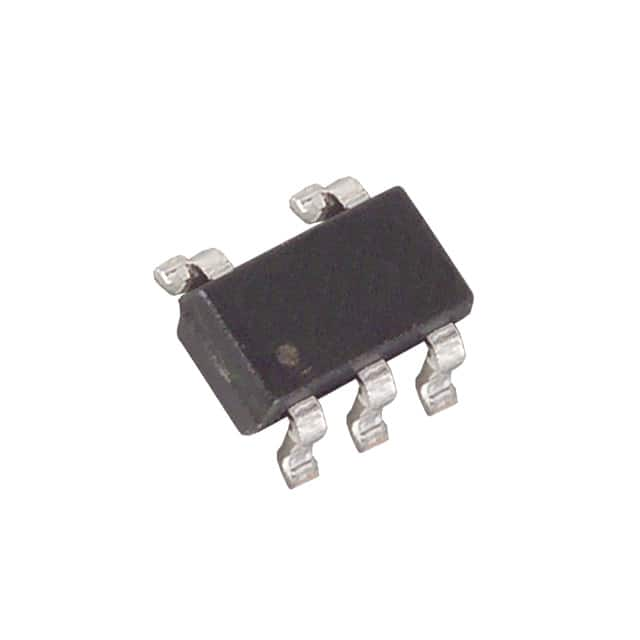MAX9140EUK-T
Product Overview
Category
MAX9140EUK-T belongs to the category of electronic components, specifically operational amplifiers (op-amps).
Use
This product is commonly used in various electronic circuits and systems where amplification of signals is required.
Characteristics
- High gain: The MAX9140EUK-T offers a high voltage gain, making it suitable for applications requiring signal amplification.
- Low noise: This op-amp has low input-referred noise, ensuring accurate signal processing.
- Wide bandwidth: With a wide frequency response range, the MAX9140EUK-T can handle signals across a broad spectrum.
- Low power consumption: This component operates efficiently with low power requirements.
- Small package size: The MAX9140EUK-T is available in a compact SOT23-5 package, allowing for space-saving designs.
Package and Quantity
The MAX9140EUK-T is packaged in a SOT23-5 package. It is typically sold in reels or tubes containing a specific quantity, such as 3000 units per reel.
Specifications
- Supply Voltage Range: 2.7V to 5.5V
- Input Offset Voltage: ±1mV (maximum)
- Gain Bandwidth Product: 50MHz (typical)
- Input Bias Current: 10nA (maximum)
- Output Current: 40mA (maximum)
- Operating Temperature Range: -40°C to +85°C
Pin Configuration
The MAX9140EUK-T features a standard pin configuration in a SOT23-5 package:
____
V+ | |
---->| |
|____|
____
IN- | |
---->| |
|____|
____
IN+ | |
---->| |
|____|
____
OUT | |
---->| |
|____|
____
GND | |
---->| |
|____|
Functional Features
- High voltage gain amplification for accurate signal processing.
- Low input-referred noise ensures minimal distortion in the amplified signal.
- Wide bandwidth allows for handling signals across a broad frequency range.
- Low power consumption for efficient operation and extended battery life.
- Small package size enables space-saving designs.
Advantages and Disadvantages
Advantages
- High gain amplification for precise signal processing.
- Low noise ensures accurate signal reproduction.
- Wide bandwidth allows for versatile signal handling.
- Low power consumption for energy-efficient operation.
- Compact package size facilitates space-saving designs.
Disadvantages
- Limited output current may not be suitable for high-power applications.
- Input offset voltage may introduce slight inaccuracies in certain precision applications.
Working Principles
The MAX9140EUK-T operates as an operational amplifier, which amplifies the input signal with high gain. It utilizes internal circuitry to provide accurate amplification while minimizing noise and distortion. The op-amp's small size and low power consumption make it suitable for various electronic applications.
Application Field Plans
The MAX9140EUK-T finds application in a wide range of electronic systems, including but not limited to: 1. Audio amplifiers: Provides amplification for audio signals in speakers, headphones, and audio equipment. 2. Sensor interfaces: Amplifies weak sensor signals for further processing in measurement and control systems. 3. Signal conditioning: Used in instrumentation circuits to amplify and condition signals from sensors or transducers. 4. Communication systems: Enables signal amplification in wireless communication devices, such as radios and transceivers. 5. Medical devices: Utilized in medical equipment for amplifying bioelectric signals, such as ECG or EEG.
Alternative Models
Several alternative models to the MAX9140EUK-T include: - LM358: A dual operational amplifier with similar characteristics and pin configuration. - TL071: A high-performance op-amp suitable for precision applications. - AD822: An instrumentation amplifier offering high accuracy and low noise.
These alternative models can be considered based on specific application requirements and design constraints.
In conclusion, the MAX9140EUK-T is an operational amplifier that provides high gain amplification with low noise and wide bandwidth. Its compact size and low power consumption make it suitable for various electronic applications. However, it has limitations in terms of output current and input offset voltage. The op-amp finds application in audio amplifiers, sensor interfaces, signal conditioning, communication systems, and medical devices. Alternative models such as LM358, TL071, and AD822 can be considered depending on specific design needs.
10个与MAX9140EUK-T在技术解决方案中的应用相关的常见问题及解答
Sure! Here are 10 common questions and answers related to the application of MAX9140EUK-T in technical solutions:
Q: What is the MAX9140EUK-T? A: The MAX9140EUK-T is a high-speed, low-power operational amplifier (op-amp) designed for various applications in technical solutions.
Q: What is the supply voltage range for the MAX9140EUK-T? A: The supply voltage range for the MAX9140EUK-T is typically between 2.7V and 5.5V.
Q: What is the maximum output current of the MAX9140EUK-T? A: The MAX9140EUK-T has a maximum output current of 30mA.
Q: Can the MAX9140EUK-T operate in single-supply mode? A: Yes, the MAX9140EUK-T can operate in both single-supply and dual-supply modes.
Q: What is the bandwidth of the MAX9140EUK-T? A: The bandwidth of the MAX9140EUK-T is typically 100MHz.
Q: Does the MAX9140EUK-T have built-in protection features? A: Yes, the MAX9140EUK-T includes built-in input overvoltage protection and output short-circuit protection.
Q: Can the MAX9140EUK-T be used in low-power applications? A: Yes, the MAX9140EUK-T is designed for low-power applications, consuming only a few milliwatts of power.
Q: What is the input offset voltage of the MAX9140EUK-T? A: The input offset voltage of the MAX9140EUK-T is typically 1mV.
Q: Is the MAX9140EUK-T suitable for high-speed signal conditioning? A: Yes, the MAX9140EUK-T is ideal for high-speed signal conditioning due to its fast slew rate and wide bandwidth.
Q: What package does the MAX9140EUK-T come in? A: The MAX9140EUK-T is available in a SOT23-5 package, which is small and easy to solder onto a PCB.
Please note that these answers are general and may vary depending on specific datasheet specifications and application requirements.


